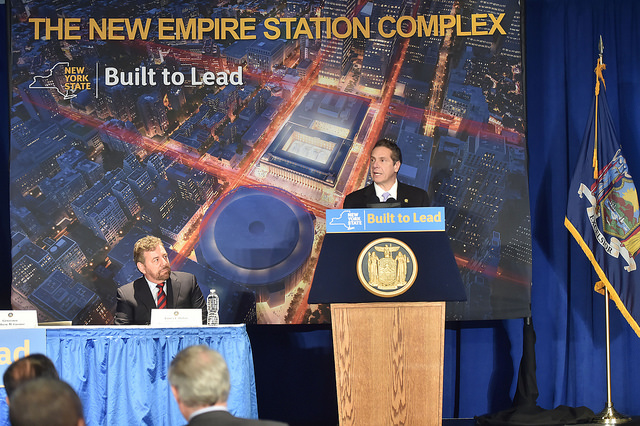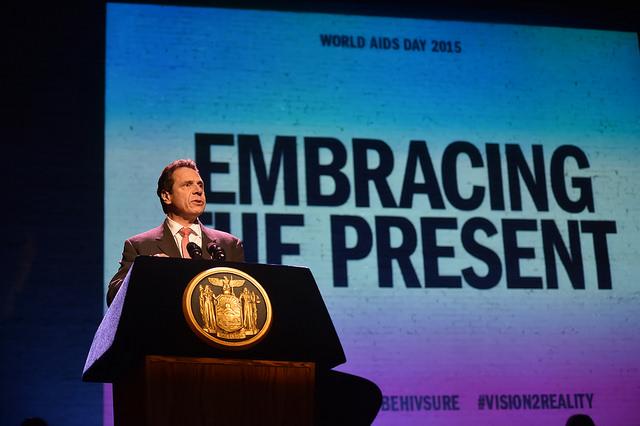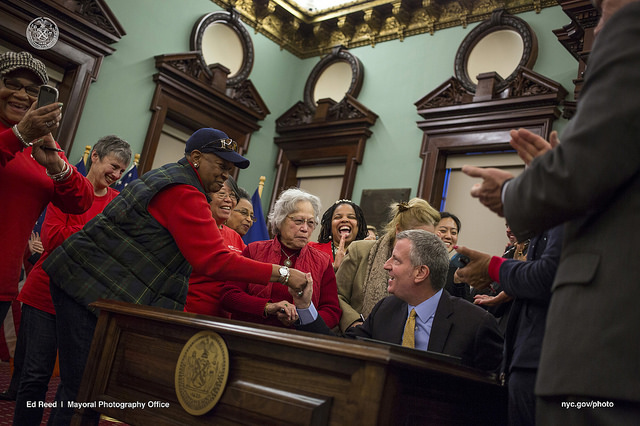To Fix Penn Station, Think Smaller

Cuomo with a new Penn Station plan (photo: Kevin P. Coughlin, Governor's Office)
Governor Cuomo deserves credit for jumpstarting the Moynihan Station project this week, albeit under a different moniker. After decades of neglect, commuters and long-distance travelers deserve light, air, and dignity.
But Cuomo's plan neglects the deeper problems that have long plagued Penn Station.
In 1970, one railroad controlled the transportation hub. After it went bankrupt, New York State took over trains to Long Island, New Jersey took over trains to the Garden State, and the Feds took on the rest.
Chaos ensued. Some routine trips now required three different types of tickets bought in three different ways. Passengers boarded from three different concourses with three different departure boards.
And worst of all, three different railroads clogged the same number of tracks.
Crowds, delays, and frustration become the norm. And after Superstorm Sandy decimated Penn's tunnels, the three railroads bickered and dithered as riders suffered.
Even with a reinvented station complex overhead, the Long Island Rail Road, New Jersey Transit, and Amtrak will still share the mostly same tracks, cramped platforms, and underwater tunnels. It's unlikely that decades of dysfunction will disappear after the ribbons are cut.
And with ridership climbing and Sandy repairs looming, the trio can barely keep up with the status quo — let alone support the expansion that the economy demands.
Cooperation would help resolve these problems. Running commuter trains between Long Island and New Jersey — rather than terminating them at Penn — could double capacity while opening up jobs to those on both sides of Manhattan. Coordinated communications and ticketing could ease crowding and nerves. And other options, such as sharing services, would slow the rate of fare increases for riders of all stripes.
To truly fix Penn Station, Cuomo must look beyond the building. Cooperation among the railroads is the missing ingredient in the governor's plan.
***
Adrian Untermyer is Deputy Director of the Historic Districts Council and was named an Emerging Leader in Transportation by the NYU Rudin Center. On Twitter @untermyer.
A New York New Year's Resolution: End the AIDS Epidemic

Gov. Cuomo (photo: Kevin P. Coughlin/Office of the Governor)
The year 2016 could go down in history as the pivotal year in New York's fight against HIV/AIDS. Nearly 35 years after The New York Times reported the first cases of what would later be recognized as AIDS, New York State is poised to become the first jurisdiction in the world to end its HIV epidemic, even without a cure, by stopping new infections and ending AIDS deaths.
Thanks to Governor Andrew Cuomo's leadership, New York State has developed a viable plan that, if fully funded and implemented, will end our AIDS epidemic by the year 2020, and can become a blueprint for all 50 states and Puerto Rico. Now, for the plan to succeed, every New York community must match Governor Cuomo's commitment with renewed energy, support, and action.
Governor Cuomo launched New York's Ending the Epidemic initiative in 2014 by announcing a three-point plan to expand HIV testing, treatment, and prevention to decrease new HIV infections from 3,000 a year in 2013 to less than 750 by 2020. He pointed out that we have the tools: Current antiretroviral medications can keep HIV-positive persons healthy and stop ongoing transmission of the virus, and, when taken as prevention, they can protect those at highest risk of HIV infection.
We now must work to remove barriers to treatment and prevention so all New Yorkers can benefit equally from these advances. These obstacles are also linked to social disparities, including lack of access to health insurance and linkage to care for mental health and substance use, secure housing, and employment opportunities, making it challenging for those living with HIV to receive and sustain treatment.
In April 2015, Gov. Cuomo endorsed the Ending the Epidemic Blueprint, consisting of 30 recommendations to achieve the governor's goals as well as seven "getting to zero" recommendations to reach zero new HIV infections, stigma, and AIDS deaths by 2020. I was proud to be a member of the task force of experts from around New York State that created the blueprint.
Just last month, the Governor made history again by pledging to include $200 million in additional state funding in his executive budget to fully implement blueprint recommendations.
Gov. Cuomo's budget commitment could go a long way to support our efforts to end HIV/AIDS here in New York City, allowing for expanded housing, transportation, and other critical services for our most vulnerable New Yorkers with HIV, as well as treatment and prevention strategies targeted to reach and retain those most in need. Amida Care serves people with HIV every day, and with stable housing and affordable care, our community members can live long and full lives.
We also know that better access to new prevention tools—including PrEP (pre-exposure prophylaxis), a daily pill that involves the use of anti-retroviral medication to prevent HIV transmission— has been shown to be over 90 percent effective.
At Amida Care, the largest Medicaid special-needs health plan (SNP) in New York State, we have demonstrated the power of providing holistic, accessible HIV and AIDS treatment and care to underserved and often overlooked communities. Amida Care is one of five Medicaid managed care plans selected to participate in Gov. Cuomo's new $2.5 million pilot program to bring 6,000 HIV positive patients into care and provide support to achieve viral suppression.
Through our specialized model of care, we have already achieved a viral suppression rate approaching 75 percent among our HIV-positive members. Successes like these save lives and produce much-needed long-term health care savings. But we must continue to push further to end the AIDS epidemic.
It is crucial to ensure that Governor Cuomo's new $200 million allocation to end the HIV/AIDS epidemic in New York is fully supported in the final budget passed by the State Assembly and Senate. This wise public investment will improve HIV health outcomes and prevent thousands of new infections, saving both lives and billions of dollars in avoided health care costs.
With the governor's budget commitment, we will have the tools, a blueprint, and the resources needed to end our AIDS epidemic. The rest is up to us.
There is much work to be done in 2016. But together, by following the governor's leadership and continuing to take action, we can achieve an AIDS-free New York by 2020.
***
Doug Wirth is the president and CEO of Amida Care, a not-for-profit health plan that specializes in providing comprehensive health coverage and coordinated care to New Yorkers with chronic conditions, including HIV and behavioral health disorders.
Paid Family Leave in NYC: Progressive Policy, Regressive Plan

The mayor (photo: Ed Reed/Mayoral Photography Office)
Paid parental leave is a hallmark of civilized societies that financially support family values. It is laudable that the City of New York wishes to be included in those ranks, starting by mandating paid parental leave for city managerial employees. But the de Blasio administration does so by having those employees pay for it themselves with a reduction in their next scheduled pay increase and the loss of two vacation days for some. That's hardly an act of a progressive employer.
Many of the managerial employees being covered by the mayor's executive order are not high-salaried executives. Some are managers whose pay starts at $57,210 annually, which translates to $27.50 per hour. City managers with 20, even 30 years of service have passed a series of civil service tests that they must pay to take. Still, some are barely making a living wage.
Most are not policy makers, this work is done by elected officials and agency commissioners. Instead, the managers make sure that the service goals set by the policy makers are met. They are the policy implementers who keep our city running 24/7 no matter who the elected officials and their top-level appointees, who largely most over $200,000 per year.
An adult with one child making $27.40 per hour barely qualifies as making living wage according to the Living Wage Calculator for New York County designed by the Massachusetts Institute of Technology. The MIT calculator was used in determining that the minimum wage should be a living wage of $15 per hour. A $15 hourly minimum wage is strongly supported by the de Blasio administration, as evidenced by the mayor's recently announced plan to move all city employees to that minimum over the next couple of years.
De Blasio believes that all those in the private sector, like entry-level fast food workers, should soon make a minimum of $15 per hour too.
Shouldn't the minimum be something more for managers who oversee the spending of millions of tax dollars for vital city services? After years of service, shouldn't those managers be well above $27.40 per hour? And, when we rightfully seek to expand family leave benefits to those managers, shouldn't they not have to sacrifice pay increases?
Cheating city managers out of a full pay increase to pay for a progressive policy like paid family leave challenges the credibility of the city's true commitment to the new parental leave policy. Back in Jamaica, Queens where I grew up it is called "putting your money where your mouth is," which is what I want to see the City do on paid family leave.
The current scheme forces managers to buy their own paid family leave and therefore reduces its impact. Paid family leave is a progressive policy - making employees pay for it is not.
***
Arthur Cheliotes is President of CWA Local 1180, a municipal union representing more than 8,500 workers and 6,200 retirees. Most work in one of dozens of New York City mayoral agencies; others at the Department of Education, Health and Hospitals Corporation, NYCHA, the Transit Authority, the School Construction Authority, and the state's Unified Court System.




